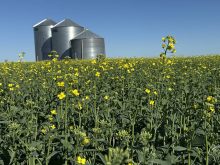Delivery contracts were added for red spring wheat and feed wheat. Dec. 10 terminations were added for some existing red spring wheat contracts. Changes shown in boldface type. Other wheat types did not change and are not shown. For full list go to www.cwb.ca. or see your elevator agent.The last 12 months have turned pork consumption expectations on their head and allowed hog producers to dream of better times ahead.
Ron Plain, an agricultural economist and hog market analyst at the University of Missouri, said the health concerns that caused people to reduce meat consumption for 20 years have been altered by the science behind low carbohydrate, high protein diets.
Read Also

Huge Black Sea flax crop to provide stiff competition
Russia and Kazakhstan harvested huge flax crops and will be providing stiff competition in China and the EU.
“We have turned the corner and are now going in the right direction. I’m not sure, but we might be in for 20 years of recapturing what we gave back. If so, man, there is going to be joy in the next 20 years in the hog business,” Plain told the Saskatchewan Pork Industry Symposium.
On average, Americans are expected to eat three pounds more meat per person this year than ever before.
Pork made up a good percentage of the increase and the result for hog growers is much stronger prices than expected, given that 2004 is expected to be a record year for slaughter.
Plain has calculated that the extra demand is the main reason why U.S. hog prices have been more than 60 percent higher than they would have been forecasted, given the record hog slaughter.
The impact in Canada has been tempered by the appreciating Canadian dollar and a shift toward beef consumption as citizens tried to help cattle producers hit hard by BSE trade restrictions. Also, the future profitability of hog production in Canada is clouded by the U.S. antidumping investigation.
Nevertheless, the low carb-high protein diet trend has benefitted producers here, providing their first solidly profitable year since the price crash of 1998.
The question is whether the meat demand will continue once the fads of the Atkins and South Beach diets fade.
Plain believes the diets have popularized and even made mainstream new nutritional thinking based on research of the past 15 years. This research produced a more sophisticated understanding of fats in nutrition and identified transfats from hydrogenated vegetable oil as the real health problem, not saturated fats from meat.
This information was building, but until Atkins and similar diets made headlines, the public and even nutrition and health professionals stuck to prejudices against red meat developed from research in the 1960s and 1970s.
The diets forced a sea change in thinking.
“Consumers’ attitude toward meat is fundamentally changed from ‘something that I should avoid if I want to live a long time’ to ‘something that I can basically consume without worry,’ ” Plain said in an interview.
“If that is the case, then I’m going to eat what tastes good and meat tastes good.”
Plain’s message was upbeat, but he and Kevin Grier of the Canadian Pork Market Review also had words of caution.
Grier, of the George Morris Centre in Guelph, Ont., said Canadian producers face more uncertainty than their American counterparts.
- There is no way to know if the U.S. antidumping duty of 14 percent will continue. If it does, will Canadian packers be able to quickly ramp up slaughter?
- What will happen to beef prices and consumption when the U.S. border reopens to live cattle trade? Will pork consumption change?
- The Canadian dollar has appreciated 30 percent against the U.S. currency in 18 months and might climb higher. How will this change profitability?
Plain added another factor that could upset hog markets on either side of the border.
Over the long term, pork consumption in Canada and the United States has increased 1.5 percent per year.
But with improved genetics and health, sow productivity is climbing by about four percent per year. In Canada in 1996, the number of pigs produced per sow per year was 15.8. By 2003 that had jumped to 19.8 pigs. Also carcass weights are climbing, adding to productivity.
That means the sow herd has to downsize by about 2.5 percent per year to avoid overproduction.
















